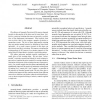SP
2008
IEEE
14 years 6 months ago
2008
IEEE
Decentralized distributed systems such as peer-to-peer systems are particularly vulnerable to sybil attacks, where a malicious user pretends to have multiple identities (called sy...
SP
2008
IEEE
14 years 6 months ago
2008
IEEE
SP
2008
IEEE
14 years 6 months ago
2008
IEEE
Rootkits are used by malicious attackers who desire to run software on a compromised machine without being detected. They have become stealthier over the years as a consequence of...
SP
2008
IEEE
14 years 6 months ago
2008
IEEE
We study formal security properties of a state-of-the-art protocol for secure file sharing on untrusted storage, in the automatic protocol verifier ProVerif. As far as we know, ...
SP
2008
IEEE
14 years 6 months ago
2008
IEEE
Attacks often exploit memory errors to gain control over the execution of vulnerable programs. These attacks remain a serious problem despite previous research on techniques to pr...
SP
2008
IEEE
14 years 6 months ago
2008
IEEE
Many basic tasks in computational biology involve operations on individual DNA and protein sequences. These sequences, even when anonymized, are vulnerable to re-identification a...
SP
2008
IEEE
14 years 6 months ago
2008
IEEE
We consider the following problem: how can two devices that do not share any secrets establish a shared secret key over a wireless radio channel in the presence of a communication...
SP
2008
IEEE
14 years 6 months ago
2008
IEEE
We present a new class of statistical deanonymization attacks against high-dimensional micro-data, such as individual preferences, recommendations, transaction records and so on. ...
SP
2008
IEEE
14 years 6 months ago
2008
IEEE
The efficacy of Anomaly Detection (AD) sensors depends heavily on the quality of the data used to train them. Artificial or contrived training data may not provide a realistic v...





